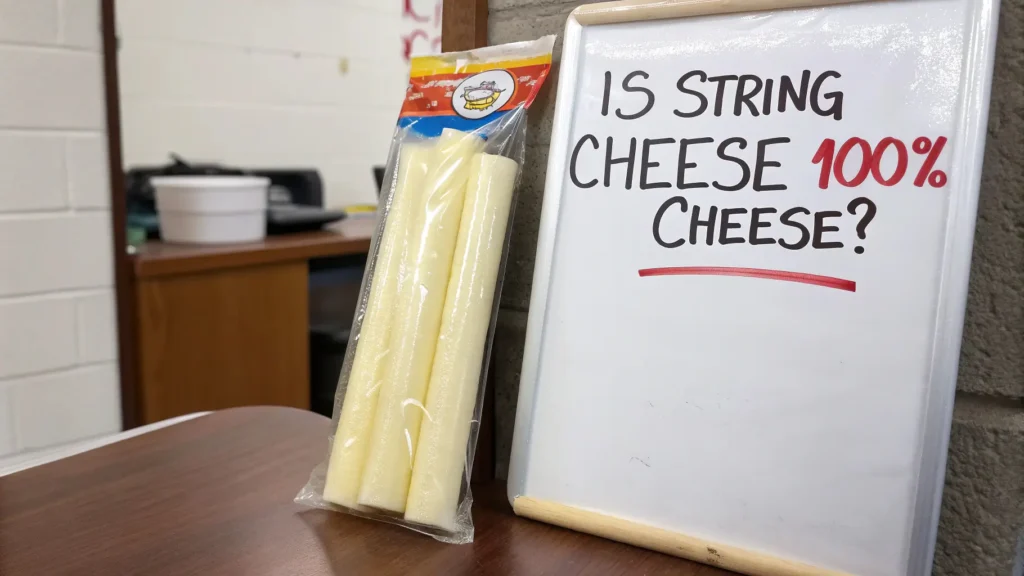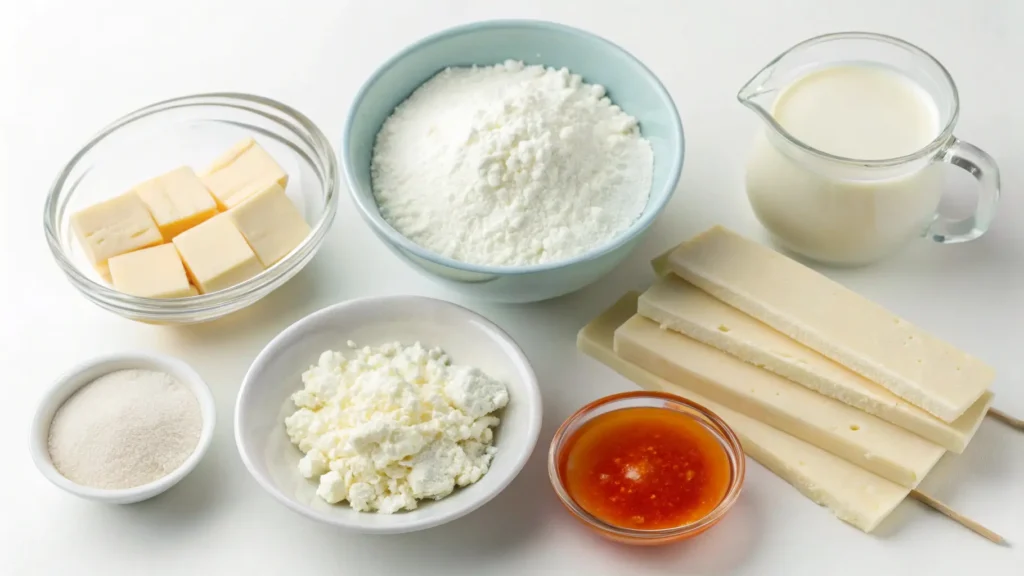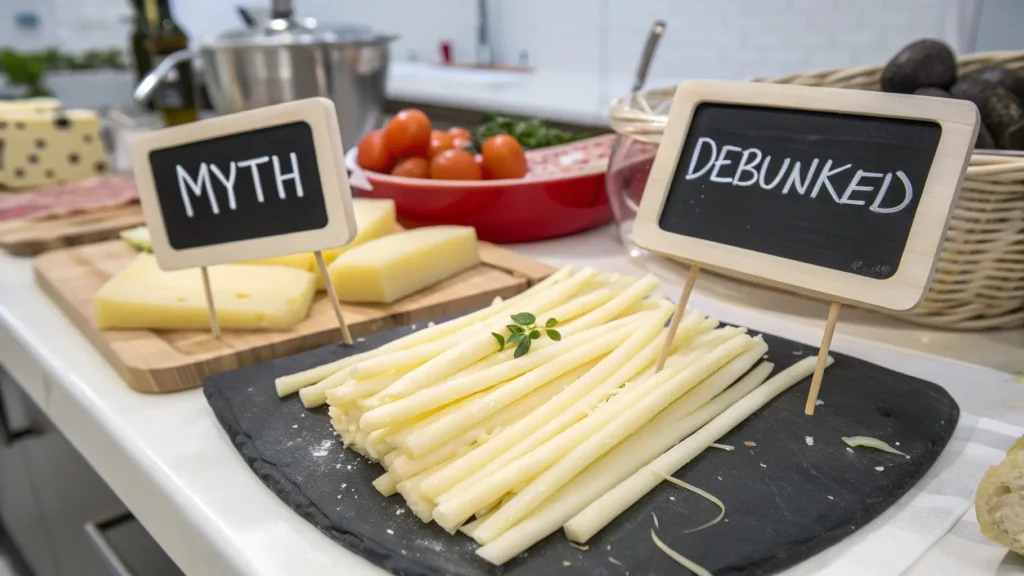String cheese is one of those snacks we’ve all grabbed on the go. Whether it’s packed in a lunchbox or enjoyed as a quick protein boost, its fun-to-eat stringy texture makes it unique. But have you ever wondered: Is string cheese 100% cheese? This seemingly simple question opens the door to a fascinating world of cheese science, nutrition, and manufacturing.

In this article, we’ll unravel the mystery behind string cheese. From its ingredients and production process to its nutritional benefits and misconceptions, you’ll learn everything you need to know. Let’s dive in, starting with a closer look at what string cheese really is.
Understanding String Cheese
What is String Cheese?
String cheese is a type of snack cheese made primarily from low-moisture part-skim mozzarella. Its standout feature is its pull-apart texture, which comes from a special heating and stretching process. This technique, called “pasta filata,” aligns the protein structures in the cheese, creating those satisfying strings.
While string cheese is most commonly associated with mozzarella, it can sometimes be made with a mix of other cheeses, like cheddar. The defining factor is its stringy texture, which remains the same regardless of the specific cheese blend.
The History of String Cheese
Interestingly, the origins of string cheese are rooted in convenience and fun. In the 1970s, cheesemakers sought to create a portable snack that retained the quality of traditional mozzarella. They discovered that by using the pasta filata method, they could produce a cheese that was not only tasty but also interactive and enjoyable to eat.
This innovation quickly became a hit with families and snack enthusiasts. Today, string cheese is a staple in grocery stores worldwide, loved for its simplicity and versatility.
How is String Cheese Made?
The magic behind string cheese lies in its production process. Here’s a quick breakdown:
- Milk Collection: It all starts with fresh milk, which is pasteurized to kill harmful bacteria.
- Curd Formation: Enzymes and bacteria cultures are added to coagulate the milk into curds.
- Stretching and Heating: The curds are heated and stretched repeatedly to align the proteins, which gives string cheese its signature pull-apart texture.
- Shaping and Packaging: The cheese is then molded into sticks, cooled, and vacuum-sealed for freshness.
Unlike many other snack options, string cheese undergoes minimal processing, which helps preserve its natural flavors and nutritional value.
Analyzing the Ingredients

String cheese is a snack we love for its convenience and flavor, but have you ever checked the ingredient list? If you’ve wondered, Is string cheese 100% cheese?, understanding what’s inside is key. Let’s break it down step by step.
What Makes Cheese 100% Cheese?
For cheese to qualify as 100% cheese, it must meet specific standards. At its core, cheese is made from milk, salt, enzymes, and bacteria cultures. These elements interact to form curds, which are then processed into the cheese varieties we know and love.
String cheese, especially when made from 100% mozzarella, fits this definition. Mozzarella itself is a natural cheese, celebrated for its mild flavor and pliable texture. When used in string cheese, it’s typically made from low-moisture, part-skim milk to give it a firmer consistency.
However, not all string cheese on the market is created equally. Some brands use additives or fillers to extend shelf life or enhance texture, which might make the product less than 100% cheese. That’s why it’s essential to look for labels like “100% natural” or “made with real mozzarella.”
Common Ingredients in String Cheese
The ingredient list of string cheese can vary slightly depending on the brand, but high-quality options tend to stick to the basics:
- Milk: Typically pasteurized cow’s milk, used as the base for creating mozzarella.
- Salt: Enhances flavor and acts as a preservative.
- Enzymes and Cultures: These help coagulate the milk and develop the cheese’s structure and taste.
- Optional Additives: Some brands may include small amounts of preservatives, like citric acid, to maintain freshness.
When considering Is string cheese 100% cheese?, it’s reassuring to know that most premium brands prioritize natural ingredients. Popular names like Sargento and Frigo often highlight their commitment to using 100% natural mozzarella.
Comparing String Cheese to Traditional Mozzarella
If you’re wondering why string cheese feels different from the mozzarella you’d find on pizza, the answer lies in its preparation. Traditional mozzarella is soft, moist, and typically sold fresh. In contrast, string cheese is made from low-moisture mozzarella, which is firmer and more shelf-stable.
This difference doesn’t mean string cheese is any less authentic. The unique heating and stretching process aligns the cheese’s proteins, giving it its iconic peel-apart texture. So, the next time someone asks, Is string cheese 100% cheese?, you can confidently explain how its production method enhances portability while keeping it real.
Nutritional Perspective
Now that we’ve looked at the ingredients, it’s time to answer another critical question: How does string cheese measure up nutritionally? Is it a healthy snack? Let’s dig into the details.
Nutritional Benefits of String Cheese
String cheese, especially when made with 100% mozzarella, packs a powerful nutritional punch. Each stick typically contains around:
- 7 grams of protein: Essential for muscle repair and overall health.
- Calcium: Supports strong bones and teeth.
- Low carbs: Ideal for those following low-carb or keto diets.
Because it’s made from real cheese, string cheese retains the natural nutrients found in milk. It’s a convenient, wholesome option for on-the-go snacking, whether you’re an athlete or a busy parent.
Is String Cheese Processed?
One common concern is whether string cheese qualifies as “processed food.” While the term “processed” often has negative connotations, string cheese undergoes minimal processing compared to other snacks.
The heating and stretching used to create string cheese don’t involve chemical alterations or artificial additives in high-quality brands. Instead, these processes maintain the integrity of the cheese while enhancing its portability. So, if someone wonders, Is string cheese 100% cheese?, you can point out that it’s closer to natural cheese than many other packaged snacks.
String Cheese vs. Other Cheese Snacks
When compared to other cheese snacks, string cheese often comes out on top. It’s lower in calories and sodium than processed cheese spreads, and it doesn’t require refrigeration like fresh cheese wedges.
Moreover, its portion-controlled packaging makes it easier to avoid overeating. If you’re looking for a protein-packed, low-calorie snack, string cheese is hard to beat.
Debunking Myths About String Cheese

String cheese has its fair share of skeptics. Some question its authenticity, while others wonder if it’s even real cheese. So, is string cheese misunderstood? Or is there more to the doubts? Let’s untangle these misconceptions and get to the truth.
Is String Cheese Just Fake Cheese?
One common myth is that string cheese isn’t “real” cheese. However, if you’ve ever wondered, Is string cheese 100% cheese?, the answer largely depends on the brand. Authentic string cheese, especially those made with 100% mozzarella, is just as real as the cheese on your favorite pizza.
The confusion often arises because of the texture. The pull-apart strands make it feel different from block cheese, but this is purely a result of the “pasta filata” stretching process, not a sign of artificiality. As long as the product label confirms it’s made from natural cheese, you can trust that it’s the real deal.
Why the Texture and Taste Differ from Traditional Cheese
Another misconception stems from string cheese’s texture. Unlike creamy brie or crumbly cheddar, string cheese feels firm and stretchy. This isn’t because it’s overly processed—it’s because of how the cheese proteins align during heating and stretching.
Additionally, the taste is mild compared to sharp cheeses, which might lead some to question its authenticity. But mozzarella, the base for most string cheese, is naturally mild. That’s what makes it a family-friendly option for picky eaters and snackers alike.
Misconceptions About String Cheese and Health
Some assume that string cheese is full of artificial additives, but many brands pride themselves on being 100% natural. If you stick with reputable names like Sargento or Frigo, you’re getting a wholesome product with minimal ingredients.
String cheese is also nutrient-rich, offering protein and calcium without excess calories. It’s a far cry from junk food and can be part of a balanced diet.
For more insights on cheese varieties and their uses, you can explore the article What Is the Stringy Cheese Called? on Tangle Recipes.
FAQs About String Cheese
Let’s tackle some of the most common questions about string cheese. Whether you’re curious about its ingredients or how to enjoy it, these answers will clear up your doubts.
Does String Cheese Contain Additives or Preservatives?
High-quality string cheese rarely contains unnecessary additives. Most use just milk, salt, enzymes, and cultures. Some may include preservatives like citric acid to ensure freshness, but these are generally harmless and used sparingly.
What Are the Best Brands for 100% Cheese String Cheese?
If you’re on a quest to find authentic string cheese, look for trusted names like:
- Sargento Natural String Cheese: Advertised as 100% natural.
- Frigo Cheese Heads: Known for their real mozzarella content.
- Organic Valley: A great choice for those seeking organic options.
Each brand highlights its commitment to quality, so you can confidently choose one that suits your taste and needs.
Is String Cheese Suitable for Gluten-Free or Dairy-Free Diets?
Here’s the good news: Most string cheese is naturally gluten-free, as it doesn’t use any wheat-derived ingredients. However, for those with dairy allergies, string cheese isn’t an option since it’s made from milk. If you’re lactose-intolerant, look for lactose-free versions or plant-based alternatives.

